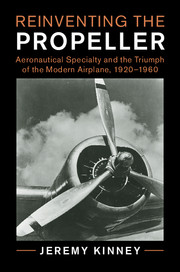Book contents
- Frontmatter
- Dedication
- Contents
- List of Figures
- List of Tables
- Preface
- Acknowledgments
- List of Abbreviations
- A Note on Terms
- 1 Introduction: The Propeller and the Modern Airplane
- 2 “The Best Propeller for Starting Is Not the Best for Flying”
- 3 “Engineering of a Pioneer Character”
- 4 A “New Type Adjustable-Pitch Propeller”
- 5 “The Propeller That Took Lindbergh Across”
- 6 “The Ultimate Solution of Our Propeller Problem”
- 7 No. 1 Propeller Company
- 8 A Gear Shift for the Airplane
- 9 Constant-Speed
- 10 “The Spitfire Now ‘Is an Aeroplane’ ”
- 11 A Propeller for the Air Age
- 12 Conclusion: The Triumph and Decline of the Propeller
- Essay on Sources
- Index
3 - “Engineering of a Pioneer Character”
Published online by Cambridge University Press: 20 April 2017
- Frontmatter
- Dedication
- Contents
- List of Figures
- List of Tables
- Preface
- Acknowledgments
- List of Abbreviations
- A Note on Terms
- 1 Introduction: The Propeller and the Modern Airplane
- 2 “The Best Propeller for Starting Is Not the Best for Flying”
- 3 “Engineering of a Pioneer Character”
- 4 A “New Type Adjustable-Pitch Propeller”
- 5 “The Propeller That Took Lindbergh Across”
- 6 “The Ultimate Solution of Our Propeller Problem”
- 7 No. 1 Propeller Company
- 8 A Gear Shift for the Airplane
- 9 Constant-Speed
- 10 “The Spitfire Now ‘Is an Aeroplane’ ”
- 11 A Propeller for the Air Age
- 12 Conclusion: The Triumph and Decline of the Propeller
- Essay on Sources
- Index
Summary
On October 1, 1918, the Propeller Testing Laboratory of the United States Army Air Service's Engineering Division began operations at McCook Field in Dayton, Ohio. The core structure within the facility was a streamlined propeller whirl-test rig that was a functional indicator of the promising future of aeronautics. In a confidential 1918 publication, the Army claimed that the collection of what was the largest and most powerful propeller testing equipment in the world was the result of “engineering of a pioneer character.” Under the leadership of civilian specialist engineers, primarily Frank W. Caldwell, the Engineering Division developed propeller testing techniques and facilities that were major contributions to the field of aeronautical engineering. The laboratory was a clear indication of the Army's cutting-edge work in aeronautics and reflected the US government's intent to wage a modern industrial and aerial war in Europe.
The story of the development of propeller whirl-testing facilities and techniques by the Army Air Service from World War I to the early 1930s highlights the almost singular role that the US government played in nurturing a new industry and its engineering community. Engineers used their experience from different disciplines to shape a new one, aeronautical engineering, as they reacted to dynamic design requirements. In the process, they created the fundamental infrastructure from which the modern airplane evolved. The pioneering propeller testing procedures and practices at the Westinghouse Electric and Manufacturing Company of East Pittsburgh, Pennsylvania, from 1917 to 1918, McCook Field from 1918 to 1928, and Wright Field in Dayton, from 1928 to 1931, demonstrated the evolution of this new professional field as it pertained to the unique and highly-sophisticated “Army style” of engineering centered on development and innovation.
Building a Foundation for Engineering Development
World War I was the catalyst for increased aeronautical development in Europe and the United States and it directly stimulated the development of the propeller. The wood, fixed-pitch propeller, which was most efficient for only one predetermined flight condition, gave satisfactory performance for aircraft that operated at low speeds and altitudes. As the war raged on, the aeronautical industries of the warring nations produced increasingly faster, more powerful, and deadlier aircraft capable of flying in excess of 100 miles per hour and ever higher altitudes. New propellers had to be stronger and able to withstand those ever-expanding performance thresholds.
- Type
- Chapter
- Information
- Reinventing the PropellerAeronautical Specialty and the Triumph of the Modern Airplane, pp. 45 - 74Publisher: Cambridge University PressPrint publication year: 2017



